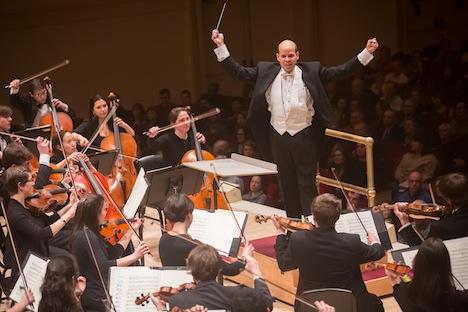News Releases
The Maestro Gets His Rematch
February 24, 2016
Daniel Hautzinger

Photo credit: Chris Lee
Raphael Jiménez has been eyeing February 27 for more years than he can remember. For Oberlin’s associate professor of conducting, this moment—the first concert of the spring semester by the Oberlin Orchestra at Finney Chapel—offers an opportunity for redemption he has craved for decades.
When Jiménez was conducting his first orchestras as a very young man in Venezuela, he once led a performance of Rachmaninoff’s Piano Concerto No. 2 with internationally celebrated pianist Monique Duphil as the soloist. Duphil had been beloved for years in the South American nation; Jiménez was desperately nervous about sharing the stage with a titanic performer at the height of her powers, and so he prepared like a madman in the days leading up to the concert. Still, he couldn’t help but feel he had not done Duphil justice.
In 2011, as Jiménez arrived in Oberlin to become the conservatory’s director of orchestras, he knew he would be reunited with Professor Duphil. And he still longed for an opportunity to revisit “Rocky II” with her.
That opportunity arrives Saturday, when Jiménez leads the orchestra in an 8 p.m. performance of the concerto with Duphil once again as the soloist. “By now,” Jiménez says with a smile, “I think I know what I’m doing.”
The program also includes only the second performance of Professor of Composition Stephen Hartke’s Symphony No. 4. The massive piece features Assistant Professor of Organ Jonathan Moyer AD ’12 and soprano Amber Monroe ’17 in solo roles.
Pieces for organ and orchestra are rare, but Hartke has been interested in the genre since childhood—and even held a college job playing organ for a church. His Symphony No. 4 was commissioned for the Los Angeles Philharmonic, which premiered the piece in 2014. The L.A. Phil’s concert hall houses a behemoth of an organ nicknamed “Hurricane Mama,” providing an ideal setting for a work for organ and orchestra.
Hartke calls the organ a fifth choir—“a chameleon” that can add shading to the other instruments and also stand on its own. At the February 27 performance, those duties will fall to Moyer.
“Hartke uses the organ in both traditional and non-traditional ways,” Moyer says. “There are the more typical organ sounds, but he has also created some very unusual effects. Though the part is quite dominant and virtuosic, you get the sense that the organ is just another texture in the orchestra, not like a solo part in a concerto.”
Hartke’s piece calls for 108 musicians, plus its two soloists. “There are not many new pieces in the symphonic repertoire that are of this magnitude,” Jiménez says.
The symphony ends with a setting of Michael Hartnett’s translation of Federico García Lorca’s poem “Sleepwalking Ballad,” which provides commentary on the dramatic arc of the preceding music.
Monroe, the soprano soloist, recently earned acclaim for her turn in the lead role of Harriet Tubman: When I Crossed That Line to Freedom. The opera was co-produced by Oberlin Opera Theater and Cleveland Opera Theater for a series of performances in late January and early February.
“I have little experience singing contemporary music,” she says. “It is very exciting because your discoveries are your own and you are given leeway to experiment with your own ideas and imagination.”
You may also like…
NEA Big Read in Oberlin Continues with Historical Re-Enactment
Oberlin College continues its National Endowment for the Arts Big Read exploration of Homegoing by Yaa Gyasi with a historical re-enactment on September 21, 2022 at 4:30 p.m. at Oberlin Public Library.
Oberlin College Recognized for Sustainability Initiatives that go Above and Beyond
Oberlin College has been named a 2021 Excellence in Energy Award winner by NRG Energy, Inc. for the significant impact of its sustainability initiatives that achieve notable environmental and social benefits.
Oberlin to launch Internship+ Commitment for students entering in fall 2022
Beginning with students entering in fall 2022, Oberlin will offer each student up to $5,000 in financial support for a qualified summer opportunity, including internships, research- and performance-based experiences, and other pre-professional activities.


